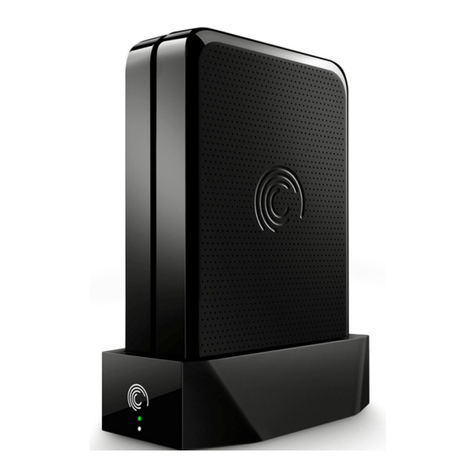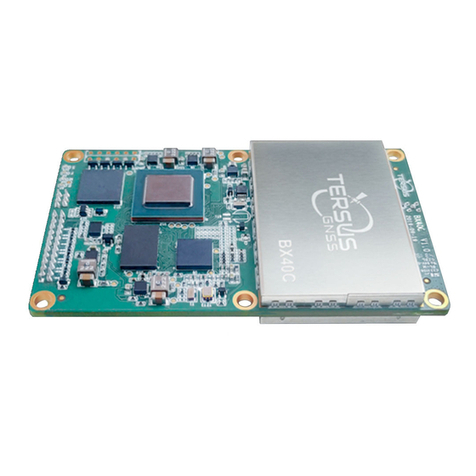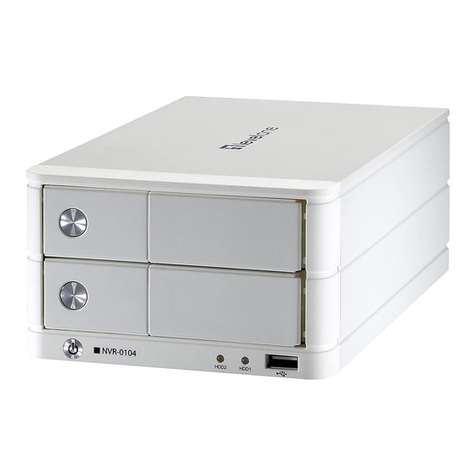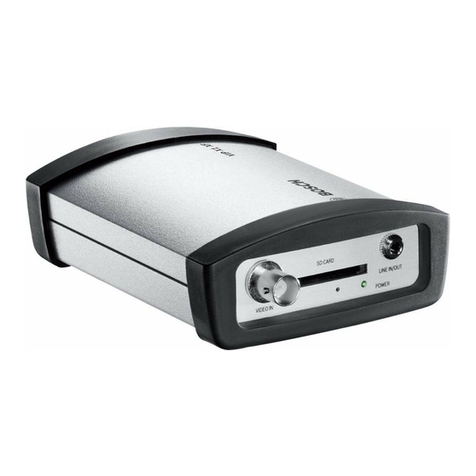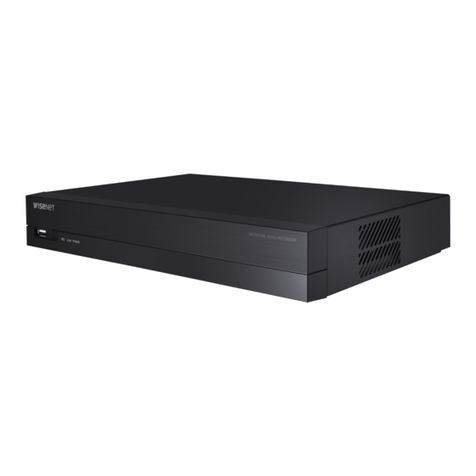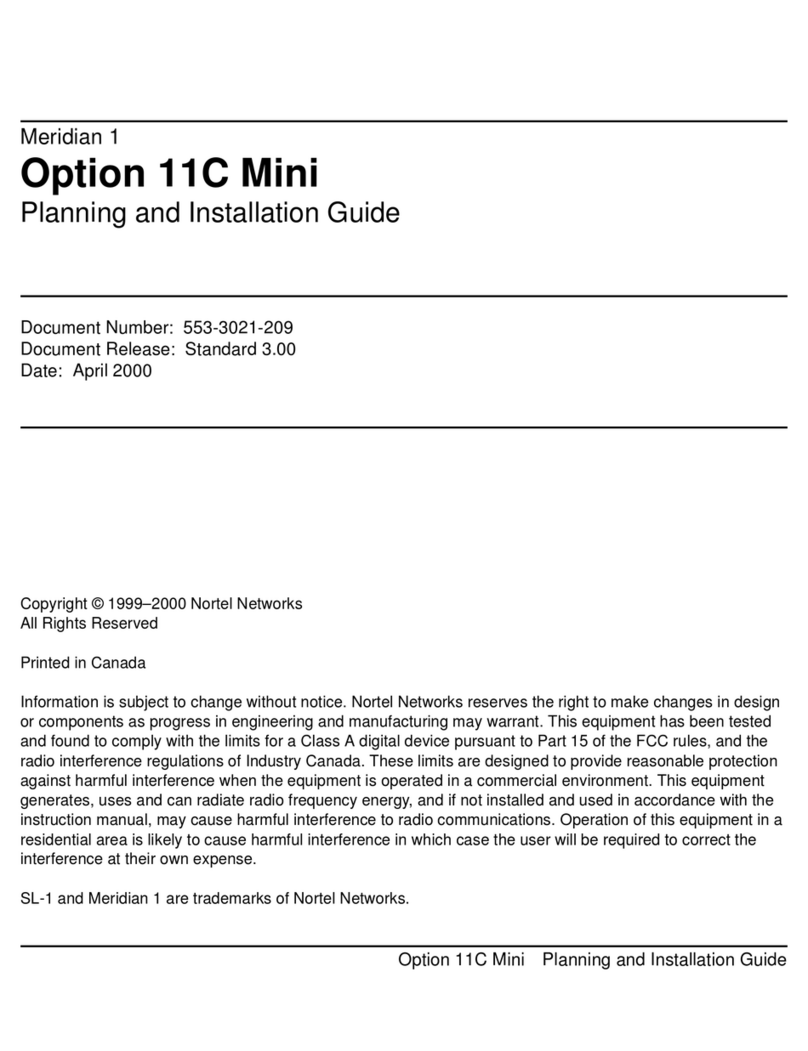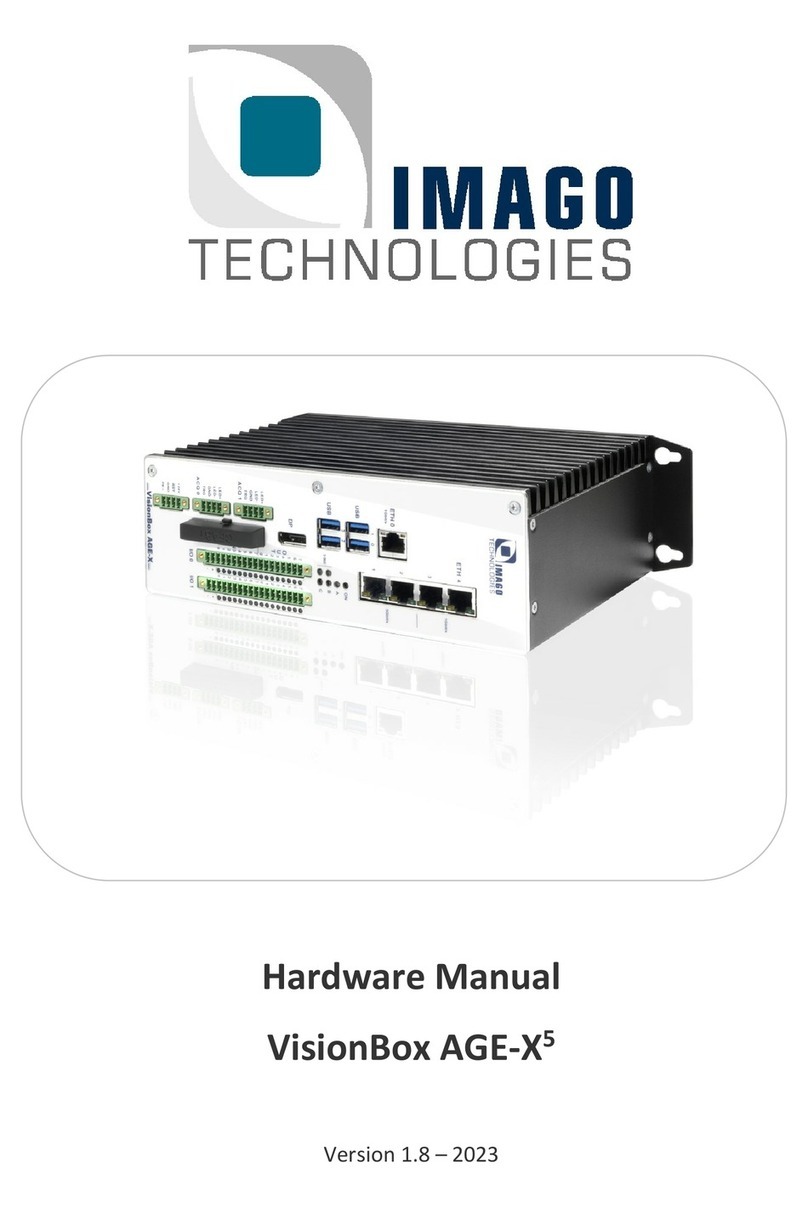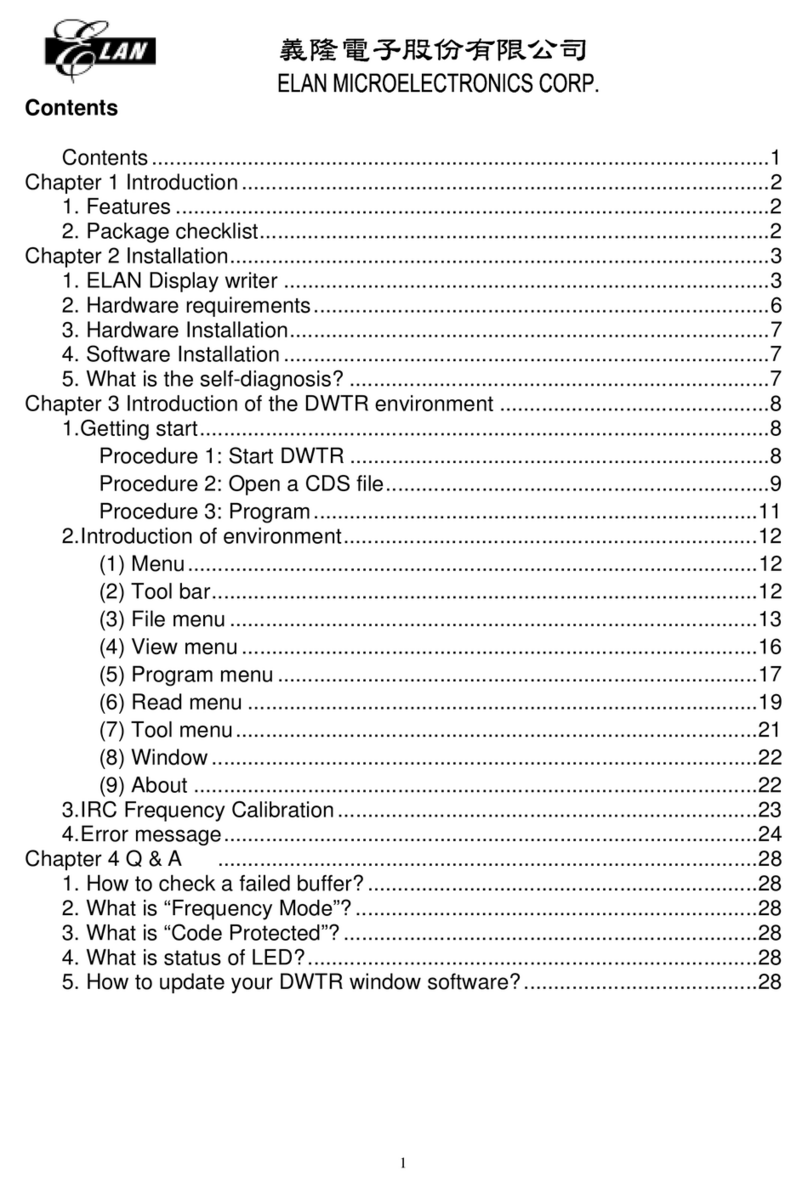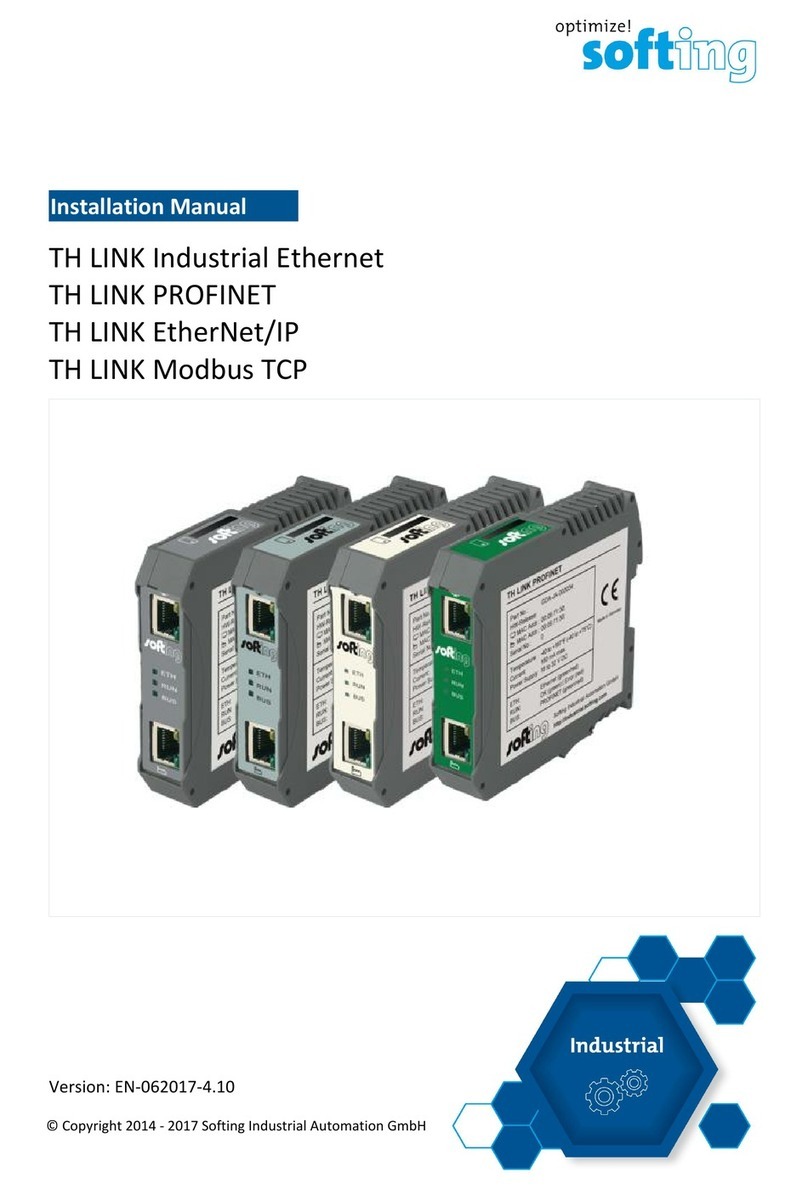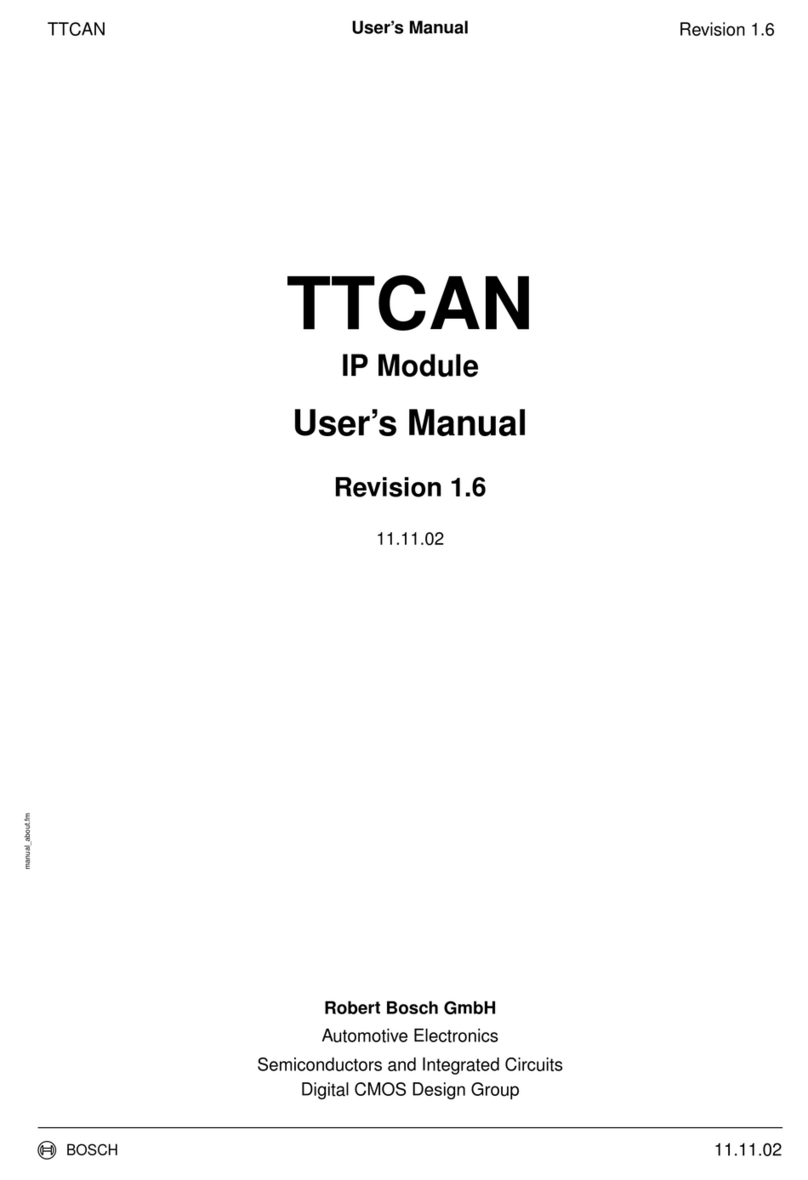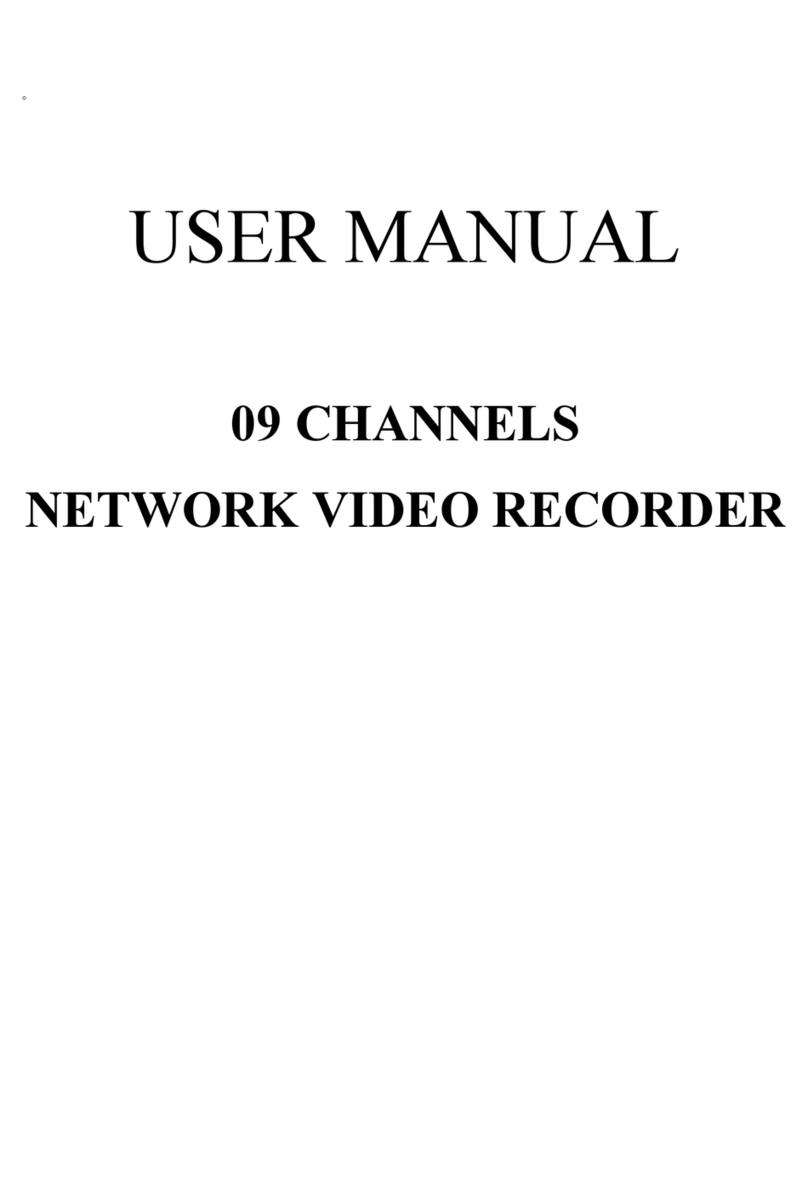Tellabs 7100 Operating and maintenance instructions

Revision B, 5/09
Copyright © 2009 Tellabs. All rights reserved.
®
General Description
76.7144FP51/2
Tellabs®7100/7100N Optical Transport System
SONET/SDH Systems
Tellabs®7190 Element Management System
Tellabs®7191 Craft Station
Tellabs® 7194 Network Management System

FCC Notification
Statement
Federal Communications Commission (FCC) Rules require that you be notified of
the following:
This equipment has been tested and found to comply with the limits for a Class A
digital device, pursuant to part 15 of the FCC Rules. These limits are designed to
provide reasonable protection against harmful interference when the equipment is
operated in a commercial environment. This equipment generates, uses, and can
radiate radio frequency energy and, if not installed and used in accordance with the
instruction manual, may cause harmful interference to radio communications.
Operation of this equipment in a residential area is likely to cause harmful
interference in which case the user will be required to correct the interference at his
own expense.
Changes or modifications not expressly approved by Tellabs Operations, Inc., in
writing can void the user’s authority to operate the equipment.
Industry Canada
Notification Statement
Industry Canada interference-causing equipment regulations require that you be
notified of the following:
This Class A digital apparatus complies with Canadian ICES-003.
Cet appareil numérique de la classe A est conforme à la norme NMB-003 du
Canada.
Copyright Statement This Tellabs manual is owned by Tellabs or its licensors and protected by U.S. and
international copyright laws, conventions, and treaties. Your right to use this manual
is subject to limitations and restrictions imposed by applicable licenses and
copyright laws. Unauthorized reproduction, modification, distribution, display or
other use of this manual may result in criminal and civil penalties.
Trademark Notice The following trademarks and service marks are owned by Tellabs Operations, Inc.,
or its affiliates in the United States and/or other countries: ACCESSMAX®,
CABLESPAN®,CEC-128®, DXX®, ®, DYNAMIC SIGNAL TRANSFER™,
EC DUO®, ENHANCED AUDIO PLUS®, EXPRESS/PATH®, FOCUS™,
INTELLIGENT SERVICE EDGE™, MARTIS®, ®, MARTISDXX®,
®, METROCARE , METROVANTAGE™, MetroWatch®,
NETREACH®, NETWISE®, SCULPTURED SOUND®, TECHNOLOGY THAT
TRANSFORMS THE WAY THE WORLD COMMUNICATES™, ®, TELLABS®,
®, TELLABS PROPARTNER™, Tellabs®ServiceAssured™Upgrade,
TELLABS. THE FUTURE OF YOUR BUSINESS. STARTING NOW™, TEL/MOR®,
THE WORLD COMMUNICATES THROUGH TELLABS™, TITAN®, VERITY®,
YOUR NETWORKING PARTNER®
Any other company or product names may be trademarks of their respective
companies.
Contact Information In an effort to improve the quality of this document, please notify Tellabs Technical
Assistance at 1.800.443.5555 in North America or 1.630.798.7070 outside North
America if any anomalous conditions are observed.
SM

General Description Contents
76.7144FP51/2, Rev B 5/09 Page 2-i
Contents Page
Section 1 Introduction 2-1
Reason for Issue ................................................................................... 2-1
Section 2 Tellabs 7100/7100N Optical Transport Series 2-2
DWDM and the Optical Layer ............................................................................ 2-2
Multiplexing Schemes.................................................................................. 2-2
Layer Management...................................................................................... 2-3
Tellabs 7100/7100N OTS Operations ................................................................ 2-3
Tellabs 7100/7100N OTS Configurations .................................................... 2-5
Embedded Operations Channel Network .................................................... 2-7
Autodiscovery .............................................................................................. 2-8
Performance Monitoring .............................................................................. 2-8
Control Plane ............................................................................................... 2-8
Ethernet Packet Support.............................................................................. 2-9
SDH Protocol Support ............................................................................... 2-10
Interoperability Features .................................................................................. 2-11
Data Communications Channel (DCC)...................................................... 2-11
IP Over DCC.............................................................................................. 2-11
OSI Traffic Tunnelled Over EON to Remote NEs...................................... 2-11
Services Between Transponders and External Equipment .............................. 2-11
System Operation and Growth......................................................................... 2-12
SPM Operation .......................................................................................... 2-12
Auto-Negotiation ........................................................................................ 2-12
Seamless Expansion ................................................................................. 2-12
Network Administration .................................................................................... 2-13
Northbound Interfaces ............................................................................... 2-13
DHCP......................................................................................................... 2-13
Power Balancing........................................................................................ 2-14
Derived Timing Synchronization ................................................................ 2-14
Section 3 Features Introduced in FP5.1.x 2-15
Control Plane Enhancements .......................................................................... 2-15
Packet Enhancements ..................................................................................... 2-16
Expanded Module Support in Tellabs 7100N OTS .......................................... 2-17
88-Channel Configurations .............................................................................. 2-17
Expanded Shelf Capacity................................................................................. 2-17
Expanded Y-cable Patch Panel Support.......................................................... 2-17
DCC Enhancements ........................................................................................ 2-17
NorthBound Interface Enhancements .............................................................. 2-18
Management Systems Features ...................................................................... 2-18
FP5.1.x Hardware ............................................................................................ 2-19
71188-IR LIAM-E88 Line Input Amplifier Module - Enhanced 88-Channel 2-19
71188-LR LRAM-E88 Long Reach Amplifier Module - Enhanced
88-Channel ................................................................................... 2-19
71188-ER ELRAM-E88 Extended Long Reach Amplifier Module -
Enhanced 88-Channel .................................................................. 2-19
71123C Line Output Amplifier Module - Enhanced 88 Channel ................ 2-19
71887B 8-Degree Reconfigurable Multiplexer Module - 88 Channel ........ 2-20
New Revision of Tellabs 7100 OTS Shelves ............................................. 2-20
714144 OMD44-1 and 714188 OMD44-45 Mux/Demux Modules............. 2-20

Contents General Description
Page 2-ii 5/09 76.7144FP51/2, Rev B
Contents Page
83.71020 Generic Breaker Frame Alarm Panel......................................... 2-20
71125A Network Interfaced Raman........................................................... 2-20
71125B Co-Propagating Raman Amplifier 700 mW .................................. 2-21
82.71114B System Processor Module ...................................................... 2-21
Dispersion Compensation Module............................................................. 2-21
71328O-M Optical Transport Network Multiplexer..................................... 2-21
71423M 40 Gbps, Multi-Port Tunable Transponder Module (FGTM-M).... 2-21
82.71423 40 Gbps Transponder Module (FGTM) ..................................... 2-22
SONET/SDH Switching Modules (SSMs).................................................. 2-22
Section 4 Management Systems Graphical Interface Software 2-23
Tellabs 7190 EMS and Tellabs 7194 NMS ...................................................... 2-23
Tellabs 7190 Element Management System Features.............................. 2-24
Tellabs 7194 Network Management System Features.............................. 2-24
Tellabs 7190 SNMP Northbound Interface (Per NE) ................................. 2-24
Tellabs 7194 XML Northbound Interface (Per NE) .................................... 2-25
Tellabs 7191 Craft Station................................................................................ 2-25
Tellabs 7196 Optical Subnet Planner............................................................... 2-25
Tellabs Management Systems Architecture..................................................... 2-26
Network Management Features....................................................................... 2-29
One-Step Upgrades................................................................................... 2-29
NE Status Indicators .................................................................................. 2-29
NE Metering Manages High-Volume Messaging Periods.......................... 2-29
NE Parameters Exported to Tellabs 7196 Planning Tool .......................... 2-29
Primary and Secondary Database Backup................................................ 2-30
Database Restore...................................................................................... 2-30
Software Upgrades .................................................................................... 2-30
Multiple NE Operations.............................................................................. 2-31
User Security Partitioning .......................................................................... 2-31
Oracle®Data Guard .................................................................................. 2-31
Retrieving Network Element TL1 Logs ...................................................... 2-31
Shelf Views with Active LEDs .................................................................... 2-32
Fault and Alarm Management.......................................................................... 2-32
Diagnostics ................................................................................................ 2-32
Alarm Profile Management ........................................................................ 2-32
Alarm Synchronization............................................................................... 2-32
Alarm Filtering............................................................................................ 2-32
Alarm Sorting Based on Multiple Criteria................................................... 2-33
Alarm/Event Time Zone ............................................................................. 2-33
Automatic Acknowledge of Transient Conditions ...................................... 2-33
Root Cause Analysis ................................................................................. 2-33
Security Management ...................................................................................... 2-34
Configuration Management .............................................................................. 2-34
Provisioning Features ...................................................................................... 2-35
Provisioning Defaults ................................................................................. 2-35
Centralized Configuration for STSn and VCn ............................................ 2-35
Wavelength Manager................................................................................. 2-35
Network Views ........................................................................................... 2-35
TID/CLLI Coordinates Import..................................................................... 2-36
Circuit Views .............................................................................................. 2-36
Circuit Discovery (Optical Layer) ............................................................... 2-36
End-To-End Provisioning of Circuits on Optical Layer............................... 2-37

General Description Contents
76.7144FP51/2, Rev B 5/09 Page 2-iii
Contents Page
End-to-End Sub-Circuit Management........................................................ 2-37
End-to-End RPR Circuit Management....................................................... 2-37
Lightpath Power Levels ............................................................................. 2-37
Performance Monitoring................................................................................... 2-38
Consolidated Performance Monitoring (PM).............................................. 2-38
Performance Reports................................................................................. 2-38
Section 5 System Applications 2-39
Control Plane Applications ............................................................................... 2-40
Point-to-Point Topology.................................................................................... 2-41
DWDM Ring Networks ..................................................................................... 2-41
Tellabs 7100N OTS.......................................................................................... 2-42
Mesh Network .................................................................................................. 2-43
Direct Connect Overview ................................................................................. 2-44
Spur Applications ............................................................................................. 2-46
Section 6 Physical Configurations 2-48
FP5.1.x Configurations..................................................................................... 2-49
44-Channel Configurations ........................................................................ 2-49
8-Degree Reconfigurable SBOADM (ROADM)................................... 2-49
4-Degree Reconfigurable SBOADM (ROADM)................................... 2-50
Tellabs 7100N SBOADM..................................................................... 2-50
44-Channel OLA ................................................................................. 2-50
88-Channel Configurations ........................................................................ 2-50
8-Degree, 88-Channel Reconfigurable SBOADM (ROADM) .............. 2-50
88-Channel OLA ................................................................................. 2-50
Main Shelf Modules for SBOADM Configurations............................................ 2-51
Tellabs 7100 SBOADM Main Shelf............................................................ 2-52
Tellabs 7100N SBOADM Main Shelf ......................................................... 2-58
Main Shelf Modules for OLA Configurations .................................................... 2-59
Tellabs 7100 OTS OLA.............................................................................. 2-60
Tellabs 7100N OTS OLA ........................................................................... 2-61
Port Shelf Modules for SBOADM Configurations ............................................. 2-63
Tellabs 7100 OTS Port Shelf ..................................................................... 2-63
Packet Subsystem in Tellabs 7100 OTS Port Shelf .................................. 2-64
Tellabs 7100N OTS Port Shelf .................................................................. 2-65
Signal Flow Diagrams ...................................................................................... 2-66
SBOADM/ROADM Configuration in Tellabs 7100N OTS .......................... 2-67
SBOADM/ROADM Configurations with Two RCMM-4D/8D...................... 2-68
SBOADM/ROADM Configurations with Four RCMM-4D/8D ..................... 2-69
SBOADM/ROADM Configurations with Eight RCMM-4D/8D .................... 2-70
SBOADM/ROADM Configurations with Eight RCMM 8D88s .................... 2-71
SBOADM/ROADM Configurations with One Shelf .................................... 2-72
Signal Flow for a SBOADM/ROADM for Port-Side Protection................... 2-73
Signal Flow for SBOADM/ROADM with Line-Side Protection ................... 2-74
Signal Flow for Spur Application with Port-Side Protection ....................... 2-75
Tellabs 7100 OTS OLA Configurations ..................................................... 2-76
Tellabs 7100N OTS OLA Configurations................................................... 2-77

Contents General Description
Page 2-iv 5/09 76.7144FP51/2, Rev B
Contents Page
Section 7 System Architecture 2-78
Tellabs 7100/7100N OTS Shelves................................................................... 2-79
Tellabs 7100 OTS Modules.............................................................................. 2-79
System Processor Module (SPM).............................................................. 2-79
82.71114B System Processor Module ...................................................... 2-80
Amplified Interface Module (AIM) .............................................................. 2-80
Data Processor Module (DPM).................................................................. 2-80
Line Input Amplifier Module-Enhanced (LIAM-E) ...................................... 2-80
Long Reach Amplifier Module-Enhanced (LRAM-E) ................................. 2-80
Extended Long Reach Amplifier Module-Enhanced (ELRAM-E)............... 2-81
Line Output Amplifier Module-Enhanced (LOAM-E).................................. 2-81
Line Input Amplifier Module - Enhanced 88-Channel (LIAM-E88)............. 2-81
Long Reach Amplifier Module - Enhanced 88-Channel (LRAM-E88)........ 2-81
Extended Long Reach Amplifier Module - Enhanced 88-Channel
(ELRAM-E88) ............................................................................... 2-81
Line Output Amplifier Module - Enhanced 88 Channel (LOAM-E88) ........ 2-82
Channel Pass-Through Module (CPM)...................................................... 2-82
Reconfigurable Channel Multiplexer Module (RCMM-xD)......................... 2-82
Reconfigurable Channel Multiplexer Module-Spur (RCMM-S) .................. 2-82
8-Degree Reconfigurable Multiplexer Module - 88 Channel
(RCMM-8D88) .............................................................................. 2-83
Channel Multiplexer Module - 44 Channel (CMM-44) ............................... 2-83
714144 OMD44-1 and 714188 OMD44-45 Mux/Demux Modules............. 2-83
SONET/SDH/Packet Fabric Module (SPFAB)........................................... 2-83
Dispersion Compensation Module (DCM) ................................................. 2-84
71125A Network Interfaced Raman........................................................... 2-84
71125B Co-Propagating Raman Amplifier 700 mW .................................. 2-84
Filler Modules ............................................................................................ 2-85
XFP/SFP Management.............................................................................. 2-85
Optical Protection and Synchronization Module (OPSM) .......................... 2-85
Tellabs 7100N OTS Modules ........................................................................... 2-86
System Processor Module (SPM-N).......................................................... 2-86
Colorless Core Module (CCM-xR) ............................................................. 2-86
Optical Line Amplifier................................................................................. 2-87
88-Channel Input Amplifiers ...................................................................... 2-87
Filler Modules ............................................................................................ 2-87
Tellabs 7100/7100N OTS Transponders ......................................................... 2-88
Multirate Transponder Module-Enhanced (MRTM-E)................................ 2-88
Universal 10G Transponder Module-Tunable (TGTM-T)........................... 2-88
81.71323-NX Enhanced 10G Transponder Module (TGTM-E) ................. 2-88
81.71423 40G Transponder Module (FGTM) ............................................ 2-89
82.71423 40 Gbps Transponder Module (FGTM) ..................................... 2-89
Subrate Multiplexer Transponder Module (SMTM-x)................................. 2-89
71328O-M Optical Transport Network Multiplexer (OTNM-D)................... 2-90
10G Subrate Multiplexer Transponder Module - Packet (SMTM-P) .......... 2-90
10G Transponder - Packet Interface Module (TGIM-P)............................. 2-90
SONET/SDH Switching Modules (SSMs).................................................. 2-91
Tellabs 7100 OTS Common Equipment .......................................................... 2-92
88-Channel Shelves .................................................................................. 2-92
83.71020 Generic Breaker Frame Alarm Panel......................................... 2-92
Breaker Frame Alarm Panel (BFAP) ......................................................... 2-92
Breaker Frame Alarm Module (BFAM) ...................................................... 2-93
Alarm Interface Panel (AIP) ....................................................................... 2-93

General Description Contents
76.7144FP51/2, Rev B 5/09 Page 2-v
Contents Page
Fan Assembly ............................................................................................ 2-93
Horizontal Distribution Panel Modules....................................................... 2-94
Tellabs 7100N OTS Common Equipment ........................................................ 2-95
Shelf with Fan Tray.................................................................................... 2-95
Telemetry and Timing Module ................................................................... 2-95
Shelf Display Module ................................................................................. 2-95
SPM-N ....................................................................................................... 2-95
Facility and System Alarms .............................................................................. 2-96
Alarm Generation....................................................................................... 2-96
Signal Monitoring ....................................................................................... 2-97
System Reliability ............................................................................................. 2-98
System Security......................................................................................... 2-99
IP Security ............................................................................................... 2-100
Network Protection Features.......................................................................... 2-100
Line-Side Protection ................................................................................ 2-100
Port-Side Protection on SMTM-U ............................................................ 2-100
OPSM Hold-Off Timer.............................................................................. 2-101
End-to-End Circuit LOS Propagation....................................................... 2-101
Y-Cable Patch Panel ............................................................................... 2-101
The OSI Data Communication Channel ......................................................... 2-102
Section 8 Performance and Maintenance Features 2-104
Facility Alarm Monitoring................................................................................ 2-104
Alarm Management ........................................................................................ 2-104
Alarm Types............................................................................................. 2-105
TL1 Interface............................................................................................ 2-105
Facility Performance Monitoring..................................................................... 2-106
TL1 Ethernet PM...................................................................................... 2-106
SNMPv3 and RMON Support to Receive Ethernet PM ........................... 2-106
Path Level PM ......................................................................................... 2-107
Transponder BER Test Signal Generation .............................................. 2-107
Accumulation and Storage....................................................................... 2-107
Optical Threshold Crossing Alert (OTCA)................................................ 2-108
End-to-End Circuit LOS Propagation ............................................................. 2-108
Client Laser Shutdown............................................................................. 2-109
Port-Side OPSM Protection ..................................................................... 2-110
Line-Side OPSM Protection..................................................................... 2-111
Maintenance Loopbacks ................................................................................ 2-112
Signal Protection ............................................................................................ 2-115
Network Protection with OPSM...................................................................... 2-117
Network Protection with OTNM-Ds ................................................................ 2-118
Network Protection with Switch Fabric........................................................... 2-119
Network Protection with Paired Transponders............................................... 2-120
Network Equipment Protection with Y-Cable Patch Panel............................. 2-121
Network Equipment Protection with OPSM.................................................... 2-122
Client Protection with Paired Transponders................................................... 2-123
Unprotected Scenario .................................................................................... 2-124
External Protection......................................................................................... 2-125
Chromatic Dispersion..................................................................................... 2-126
How to Calculate ..................................................................................... 2-128
Polarization Mode Dispersion ........................................................................ 2-129

General Description 1. Introduction
76.7144FP51/2, Rev B 5/09 Page 2-1
1. Introduction
1.01 This document provides an overview of Tellabs 7100®Optical Transport
System (OTS) series of products and network configurations, including the Tellabs
7100N®Optical Transport System (OTS). It details system features,
configurations, and applications. It also provides an overview of dense wavelength
division multiplexing (DWDM) technology, including multiplexing schemes and
optical layer management. A detailed description of system architecture and
hardware is provided.
1.02 This document is intended for network planners and engineers. Customers
can use this document to determine the suitability of implementing Tellabs 7100
OTS and Tellabs 7100N OTS technology into their optical networks. Users of this
manual should be familiar with telephone industry technology.
Reason for Issue 1.03 Tellabs reissues this manual from Revision A to Revision B to include the
changes in Table 1.1, page 2-1. Change bars indicate the changes Tellabs made
from the previous to latest revision.
Table 1.1 General Description Revision History
Revision Change History Release Date
A Initial release for Tellabs 7100 Optical Transport System FP5.1.x. 1/09
B Update Features Introduced in FP5.1.x, page 2-15 and support for those features
throughout the document.
5/09

2. Tellabs 7100/7100N Optical Transport Series General Description
Page 2-2 5/09 76.7144FP51/2, Rev B
2. Tellabs 7100/7100N Optical Transport Series
2.01 This section provides an overview of DWDM systems and the Tellabs
7100/7100N OTS operations.
DWDM and the Optical Layer
2.02 Dense wavelength division multiplexing (DWDM) is an optical technology
used to increase the capacity and flexibility of the optical infrastructure. In a DWDM
system, multiple optical signals are transmitted over multiple optical wavelengths
on a single optical fiber. Traditional systems require multiple optical fibers to
transmit multiple optical signals.
2.03 DWDM is a multiplexing hierarchy that leverages the optical layer of the
transmission network. The optical layer interfaces the digital layer at the optical
termination equipment, which can be considered part of both the electrical and the
optical layer. The optical layer provides multiplexing schemes and management
that are not present on the digital layer of the network.This optical infrastructure
supports multiple data rates (for example, 622 Mbps, 2.5 Gbps, 10 Gbps),
synchronous optical network (SONET) signal rates, and synchronous digital
hierarchy (SDH) signal rates.
2.04 DWDM systems are divided into integrated and open systems. In
integrated DWDM systems, the DWDM transmitter and receiver functionality is
integrated into the transmitter/receiver of the digital transmission equipment. In
open DWDM systems, special DWDM transmitter/receiver interface units
(transponders) are used to provide the interface between the DWDM multiplexers
and the adjacent digital transmission equipment.
Multiplexing Schemes
2.05 In DWDM systems, the signals to be multiplexed and demultiplexed are
characterized by different optical wavelengths. The optical wavelengths of the
Tellabs 7100/7100N OTS are chosen in agreement with the International
Telecommunications Union (ITU-T) recommendations specifying up to 44 DWDM
channels with center wavelengths placed in the erbium doped fiber amplifier
(EDFA) gain band with 100 GHz between neighboring channels, and 88 DWDM
channels with center wavelengths placed in the erbium doped fiber amplifier
(EDFA) gain band with 50 GHz between neighboring channels. Wavelengths are
placed from 1529 nm to 1563 nm, where the EDFA gain bands exhibit the most
wavelength uniform gain characteristics.

General Description 2. Tellabs 7100/7100N Optical Transport Series
76.7144FP51/2, Rev B 5/09 Page 2-3
Layer Management
2.06 The optical layer is managed as the digital (SONET/SDH) layer is, except
for the physical transport of remote management data. In the optical layer,
supervisory and management data from remote DWDM equipment cannot be
transmitted over embedded digital channels. Instead, this data is transmitted over
an independent optical supervisory channel (OSC) at 1510 nm. The OSC is
terminated, processed, and retransmitted at the DWDM equipment that interfaces
the optical transmission fiber.
Tellabs 7100/7100N OTS Operations
2.07 The Tellabs 7100 OTS is a metro, dense wavelength division multiplexing
(DWDM) system based on a parallel architecture that provides scalable,
non-service affecting growth to 88 protected wavelengths without network
re-engineering. The Tellabs 7100N OTS is a full-featured system providing eight
protected wavelength for niche applications within a Tellabs 7100 OTS network.
These systems support ITU-T Recommendation G.709 Optical Transport Network
(OTN)-based transport, enabling transparent high-capacity services. Services
such as Carrier Ethernet, video, Storage Area Network, SONET, and SDH are
carried on a shared infrastructure, scaling capacity as needed.
2.08 The Tellabs 7100/7100N OTS is built on unique, multi-patented system
technologies that enable true next generation multiservice delivery. It features an
integrated dynamic optical core combined with an intelligent services interface that
delivers Add/Drop Multiplexer (ADM) capability on a single blade (SMTM-U
module) in client ranges of 100 Mbps to 40 Gbps. The dynamic optical core
enables service providers to meet today’s network needs while supporting the
ability to effortlessly deploy additional nodes for future expansion via a
multi-degree Reconfigurable Optical ADM (ROADM).
2.09 The intelligent services interface can replace a currently installed ADM ring
with a simple pair of modules, eliminating the costly implementation of stacked
ADM rings, back-to-back ADM boxes between rings, and multiple rows of
supporting equipment. Linear add/drop, ring, and mesh optical network topologies
are supported on the same base platform. Service is easily changed by equipping
endpoints with specific interface modules.
2.10 Tellabs 7100/7100N OTS provides the following benefits:
• fiber relief in fiber-constrained networks
• wavelength and capacity-based services
• deployment of new services without re-engineering networks
• efficient aggregate and transport of different types of traffic in
metropolitan (metro) areas
• variable applications such as mesh, ring, and point-to-point

2. Tellabs 7100/7100N Optical Transport Series General Description
Page 2-4 5/09 76.7144FP51/2, Rev B
2.11 The Tellabs 7100/7100N OTS offers a single, flexible platform that can
support current ADM and Wavelength Division Multiplexing (WDM) ring
capabilities and ensure a smooth migration to future packet-based services over
mesh networks. This section provides an overview of the Tellabs 7100 optical
transport series of products. The Tellabs 7100 series includes the following
products.
• Tellabs 7100 Optical Transport System (OTS)
• Tellabs 7100N Optical Transport System (OTS)
• Tellabs 7190®Element Management System (EMS)
• Tellabs 7191®Craft Station
• Tellabs 7194®Network Management System (NMS)
• Tellabs 7196®Optical Subnet Planner
2.12 Hardware elements of the Tellabs 7100/7100N OTS provide support for
higher bandwidth applications and enhanced access. Hardware modules include
2.5G, 10G, and 40G transponders, reconfigurable multiplexers, multiplexers to
support spur applications, packet multiplexers, colorless core multiplexers for
high-density metro applications, optical protection modules, SONET/SDH/Packet
module for digital cross-connects, intermediate- and long-reach amplifiers, system
processors, and data processors. Multirate transponders interface transmission
equipment at client rates between 100 Mbps and 10.7 Gbps, including Fibre
Channel, OC-3/STM-1, OC-12/STM-4, OC-48/STM-16, OC-192/STM-64,
OC-768/STM-256, Gigabit Ethernet (GbE), OTU2, OTU3, and 10 GbE.
Tellabs 7100N OTS 2.13 The Tellabs 7100N OTS is a compact version of the Tellabs 7100 OTS that
can add or drop eight protected wavelengths and pass through up to 88
simultaneous channels. This product provides a 2-degree DWDM system
(populated in 1-degree increments) comprised of up to seven 30-AMP shelves and
a subset of Tellabs 7100 OTS transponder modules. It can be deployed as a
one-shelf optical line amplifier (OLA), six-shelf OLA to support direct connect
applications, or as a 2-degree SBOADM with one main shelf and up to six port
shelves in 19- or 23-inch racks. The following modules are deployed in this
application: SPM-N, CCM-IR, CCM-LR, OLA-IR, OLA-LR, LIAM-E88, LRAM-E88,
ELRAM-E88, BFM, and CFM. This system also supports the following
transponders: SSM-D, SSM-X, OTNM-D, FGTM, FGTM-M, SMTM-P, TGIM-P,
82.SMTM-U, 82.TGTM-E, and 82.MRTM-E. Slots are paired in the shelf backplane
to accommodate interdependent module applications.
Tellabs 7190/7194
Management Systems
2.14 The Tellabs 7190/7194 management systems (Tellabs 7190 EMS and
Tellabs 7194 NMS) provide integrated management of Tellabs 7100/7100N OTS
NEs.The software features listed below provide support for higher bandwidth
applications and enhanced access capabilities:
• performance monitoring of optical, Packet, SONET, SDH, and
Ethernet traffic
• automatic optical power management and equalization
• end-to-end provisioning at one screen
• automatic laser transmit power shutdown upon fiber cut and automatic
turn-up following restoration
• optical supervisory channel at OC-3/STM-1 rate

General Description 2. Tellabs 7100/7100N Optical Transport Series
76.7144FP51/2, Rev B 5/09 Page 2-5
• CLI interface for packet signaling
• TL1 Gateway Network Element (GNE) functionality
• Embedded Operations Network (EON)
• TL1 interface for system management
• XML/TMF/SNMP/CORBA Northbound Interfaces
Tellabs 7100/7100N OTS Configurations
2.15 Tellabs 7100/7100N OTS supports the following 44- and 88-channel
network configurations in FP5.1.x:
2.16 The following network configurations are supported:
__ Tellabs 7100 Single Bay OADM (SBOADM) - The Tellabs 7100 OTS
single bay optical add/drop multiplexer (SBOADM) is a single network
element with multiple DWDM interfaces. A four-degree SBOADM
requires one main shelf, supports up to eight port shelves, and
operates within a 44-channel plan. An eight-degree SBOADM requires
two main shelves and supports up to eight port shelves, and operates
within a 44- or 88-channel plan.
__ Tellabs 7100 Optical Line Amplifier (OLA) - a 44- or 88-channel OLA
can be configured for short, medium, or long spans. The OLA does not
support add/drop functions, but can be upgraded to a 2-degree node
SBOADM without affecting traffic.
__ Tellabs 7100N OTS SBOADM - the main shelf has up two DWDM
interfaces, A-side through B-side and supports eight protected
wavelengths. The Tellabs 7100N OTS SBOADM is supported only in
44-channel systems.
__ Tellabs 7100N OLA - a 44- or 88-channel OLA can be configured for
short, medium, or long spans. The OLA passes through up to 44
channels and does not support add/drop functions. This OLA is
interchangeable with Tellabs 7100 44-channel OLA.
Note: For complete descriptions of Tellabs 7100/7100N system modules and
slot assignments per configuration, refer to Tellabs 7100 System
Engineering and Tellabs 7100N System Engineering.
2.17 A sample network of Tellabs 7100 series of products is illustrated in Figure
2.1, page 2-6.

2. Tellabs 7100/7100N Optical Transport Series General Description
Page 2-6 5/09 76.7144FP51/2, Rev B
Figure 2.1 FP5.1.x Tellabs 7100/7100N Series Optical Transport Products Network
DCN
Tellabs 7190 EMS
Tellabs 7194 NMS Spur
2-degree
SBOADM
Tellabs 7100N
2-degree
SBOADM
Tellabs 7100N
2-degree
SBOADM
Tellabs 7100N
4-degree
SBOADM
Tellabs 7100
2-degree
SBOADM
Tellabs 7100
4-degree
SBOADM
Tellabs 7100
4-degree
SBOADM
Tellabs 7100
(also the PGNE)
2-degree
SBOADM
Tellabs 7100
OLA
Tellabs 7100N
2-degree
SBOADM
Tellabs 7100N
OLA
Tellabs 7100N
2-degree
SBOADM
Tellabs 7100N
N
N
N
N
N
N
N

General Description 2. Tellabs 7100/7100N Optical Transport Series
76.7144FP51/2, Rev B 5/09 Page 2-7
Embedded Operations Channel Network
2.18 The Embedded Operations Channel Network (EON) provides Embedded
Operations Channels (EOCs) to route management traffic using Internet Protocol
(IP) through an internal network among the NEs.
2.19 One NE in the EON is provisioned as a gateway NE (PGNE-1) and routes
management traffic between the external DCN and the other NEs (PRNEs) in the
EON. The PGNE-1 manages PRNEs through the Tellabs 7190 EMS and Tellabs
7194 NMS, acting as an entry point from the external DCN and enables packet
routing among the PRNEs after an IP address is configured for each. A secondary
gateway (PGNE-2) provides redundancy so that a single optical link failure does
not cause a communication interruption between the Tellabs 7190/7194
management systems and any NE in the ring.
2.20 Tellabs recommends limiting to 30 the number of PRNEs assigned to a
PGNE. When a network exceeds this limit, the EON can be partioned into two
EONs by provisioning one of the PRNEs as a second PGNE-1 and modifying the
traffic paths around that PRNE. Refer to the Tellabs 7100/7100N Craft Station User
Guide for detailed procedures on partitioning NEs. Figure 2.2, page 2-7 illustrates
the resulting two EONs interconnected via DWDM links after partitioning.
Figure 2.2 Embedded Operations Network
DCN
Ring 1 Ring 2
EMS or OSS Remote Management (TL1 or Telnet)
PGNE-1-1 PGNE-1-2 PGNE-2-1 PGNE-2-2
EON domain #1 EON domain #2
Link B
Link A
= PGNE
= PRNE

2. Tellabs 7100/7100N Optical Transport Series General Description
Page 2-8 5/09 76.7144FP51/2, Rev B
Autodiscovery
2.21 Autodiscovery is a self-inventory feature that enables the Tellabs
7100/7100N NEs to report their inventory to the Tellabs 7190/7194 management
systems. On system startup, the NE performs a self survey to determine which
hardware components are present. This information is retrieved by the system
manager when it is connected to the NE. If there is a discrepancy between the
configurations stored by the management system and the NE, the NE is assumed
to have the valid configuration.
Performance Monitoring
2.22 Performance monitoring is the continuous, nonintrusive collection of
system performance data and is used to determine the operational status of the
network and the quality of service that the network is providing. PM checks for
specific types of signal information and helps identify the cause of network
transmission problems. PM is detailed in Facility Performance Monitoring,
page 2-106.
Control Plane
2.23 The Tellabs 7100 OTS Control Plane feature provides rapid circuit
provisioning across mesh architectures in transport networks. Control plane
functionality is based on the ITU-T automatically switched optical network (ASON)
architecture and utilizes IETF generalized multi-protocol label switching (GMPLS)
protocols as extended by the OIF. It is embedded in the SPM and applied at STS
or VC termination points on paired SMTM-U module facilities operating in SPFAB
mode.
2.24 NEs are network aware in control plane applications, providing faster
set-up and tear-down of call paths across the network. The call path is established
at the STS or VC layer. The control plane automatically manages a link resource
database in real-time to provide constraint-based routing and traffic engineering.
The Tellabs 7100 OTS control plane application interfaces traditional and
management plane systems to coordinate traffic and network resources.
2.25 Tellabs 7100 OTS Control Plane supports calls across multiple domains
and flexible path protection at the STS/VC level. Re-designed protection schemes
in FP5.1.x streamline provisioning requirements while enhancing reliability to
control plane traffic.
2.26 Control Plane 1+1 (CP 1+1) protection provides two diverse connections
(working and protected) between the ingress node and the egress node of a
protection domain. This protection scheme is supported on the drop-side and the
line-side between Tellabs 7100 OTS NEs within the Tellabs 7100 OTS control
plane network (I-NNI). CP 1+1 protection is not supported on drop-side or line-side
facilities provisioned between a Tellabs 7100 OTS NE and control plane entities
outside of the Tellabs 7100 OTS network where only LAPS is supported over the
E-NNI.

General Description 2. Tellabs 7100/7100N Optical Transport Series
76.7144FP51/2, Rev B 5/09 Page 2-9
2.27 Flexible Path Protection is a protection scheme that removes previous
shelf-slot pairing constraints and enables protection port pairing between any two
ports on the line side, or any two ports on the drop side. It allows any port-side
termination to be protected by any other port-side termination and any line-side
termination to be protected by any other line-side termination within the same shelf.
Protection port pairing with a line-side port and a drop-side port mixed pair is not
supported. A protection port pair constitutes a Path Protection Group (PPG)
supported by STSn/VCn path layer protection. These Path Protection Groups
(PPG) are automatically created when the cross-connect is provisioned. For CP
1+1, two PPGs are created – one at the ingress/source node, and one at the
egress/destination node.
2.28 Dynamic re-route supports multiple repair points for a signal path and
permits automatic recovery from node failures with an efficient use of resources
that are used only during route restoration, unlike Control Plane 1+1 (CP 1+1)
protection where resources are pre-allocated. Dynamic re-route is supported in
single domains and across multiple domains. When dynamic re-route restoration
is provisioned, failure indications are propagated to repair nodes to direct an
alternate route connection to bypass the call path. In the event of resource
contention among multiple dynamic calls or simultaneous failures along the call
path, crankback is used to address these conditions and retry failed calls.
Ethernet Packet Support
2.29 Packet subsystems are created on Tellabs 7100 OTS port shelves when
packet modules (DPM, SPFAB, SMTM-P, and TGIM-P) are present and
provisioned. Packet subsystems are created on Tellabs 7100N OTS port shelves
when SMTM-P or TGIM-P are present and provisioned. The Packet subsystem
can be managed with the Tellabs 7190/7194 management system or a Command
Line Interface (CLI). Packet-based transponder modules, SMTM-P and TGIM-P,
manage the ingress and egress ports for traffic flow. SMTM-P modules are
equipped with small form pluggables (SFPs) designed to support traffic signal rates
that interface the module. Refer to Table 2.1, page 2-9.
2.30 Supported features include MAC Bridging, VLAN Bridging, an 802.3
compliant MAC client interface, Packet security, Packet fault management, Packet
performance monitoring, multicasting, synchronized Ethernet, and line-side RPR
protection.
Table 2.1 SMTM-P/TGIM-P Specifications
Port Interfaces SMTM-P TGIM-P
Number of Interfaces 10 1
Pluggable Optics SFP-based XFP-based
Data Rates 10 Mbps–1 Gbps 10 Gbps
Protocols 10/100/1000 Mbps
BaseT
GbE (1 G Optical)
100Base-FX
10 G Ethernet LAN

2. Tellabs 7100/7100N Optical Transport Series General Description
Page 2-10 5/09 76.7144FP51/2, Rev B
2.31 In Tellabs 7100 OTS applications, the SONET/SDH/Packet Fabric
(SPFAB) module provides a switch matrix for SONET/SDH signaling and Packet
traffic to maximize system integration and bandwidth efficiency. It interfaces
SMTM-U, SMTM-P, and TGIM-P modules to switch Packet and STS/VC-level
cross-connects.
2.32 Packet applications support both SNMPv2 and SNMPv3. Quality of
service certifications include Metro Ethernet Forum (MEF) services certification:
E-Line service, E-LAN service, and Ethernet Private Line (EPL). Performance
monitoring enhancements include Weighted Random Early Detection (WRED)
congestion management, traffic-shaping queues, and continuity checks.
2.33 Improved fault management for 802.3 compliant MAC/PHY interfaces
include Far End Fault Indication (FEFI) for 100FX interface, LOSYNC for NE IEEE
802.3 compliant MAC interface, signal degrade and signal fail conditions detected
on incoming Ethernet traffic based on errored frames, provisionable alarm profiles,
and additional alarms and conditions retrieved via SNMPv2c traps.
2.34 Traffic enhancements include tunneling Layer 2 control frames
transparently (spanning tree bridge protocol data units and GVRP packets) at
Provider Edge Bridge points. Ethernet types are filtered at the module port to
reduce congestion. Link aggregation groups are managed by SNMPv2.
SDH Protocol Support
2.35 A suite of Tellabs 7100 OTS and Tellabs 7100N OTS features are provided
in SDH signaling formats. Transparent STMnT (Synchronous Transfer Mode)
signals are introduced to multiplex SDH-based traffic onto a single fiber to reduce
fiber exhaust. STMnTs transport Virtual Containers (VC-4, VC-4-4C, or VC-4-16C)
through the network untouched.
2.36 This feature also uses VCn grooming to support multiple types of traffic,
including virtual concatenation. This utilizes the capacity provided by DWDM
applications and eliminates the requirement for distinct ADMs. Within the Tellabs
7100 NE, distinct VCs may be individually cross-connected onto different STM-xs,
which are associated to DWDM channels. Cross-connect terminations VC-4,
VC4NV, VC-4-4C, and VC-4-16C are supported. Signals can be concatenated into
groups via VC4NV (Level 4 Virtually Concatenated) facilities for provisioning and
transport.
2.37 CRC4 framing format and E1 signaling are also supported. Signal
protection is provided in both 1+1 protection and SNCPRING protection schemes.
Graphical representations of both world maps and actual operating NEs are
provided for visual provisioning.
Note: In SDH standards, it is possible to support either high order VC-3 or low
order VC-3 (TUG3 mapping). The Tellabs 7100/7100N OTS only supports
high order VC-3 path layer entities per ITU-T G.707. Customer
provisioning and use of VC-3 should carefully consider ITU-T
recommendation for Multiplexing of AU-3s via AUG-1 (refer to ITU-T
G.707/Y.1322 12/2003 Figure 7-4) in order to avoid any interruptions in
traffic.

General Description 2. Tellabs 7100/7100N Optical Transport Series
76.7144FP51/2, Rev B 5/09 Page 2-11
Interoperability Features
2.38 Interoperability features are built in to the Tellabs 7100/7100N OTS for
seamless integration into multiple vendor network.
Data Communications Channel (DCC)
2.39 DCC allows the messaging specific to multi-vendor devices in a Tellabs
7100 network to flow through the Tellabs 7100 NE that is provisioned as the
network Gateway Network Element (GNE). The GNE serves as a conduit for
communication between non-Tellabs management systems and the sub-tending
multi-vendor devices they support, allowing both messaging and software
downloads via an OSI-based Data Communication Network. DCC processing
routes messages between the DCN interface, the SPM, the DPM, and the DCC
interfaces on the SMTM-Us.
IP Over DCC
2.40 IP over DCC allows subtended SONET/SDH platforms to access an
IP-based DCN. On the Tellabs 7100 OTS, it allows access to the signaling
communication network (SCN) in control plane applications. IP traffic presented
over the DCC may be locally processed or forwarded to another PRNE or to the
PGNE.
2.41 Establishing an SCN expedites traffic processing by directing signaling
and management traffic to different physical ports on the NE. The SCN on the
Tellabs 7100 OTS is established via OCn, VCn, and HDP port provisioning.
OSI Traffic Tunnelled Over EON to Remote NEs
2.42 The management functions of GNEs can be extended to SDH/SONET
ADMs that subtend remote Tellabs 7100/7100N NEs by tunneling OSI traffic over
the EON to allow the PRNE to serve as a single GNE in the SDH/SONET ADM
subnetwork. The NE supports up to 64 OSI associations per TCP session and up
to 15 TTD TCP sessions.
Services Between Transponders and External Equipment
2.43 The ROADM/SBOADM DWDM optical network components in a Tellabs
7100/7100N OTS application can be decoupled in Tellabs 7100 OTS networks so
that Ethernet, SONET, and SDH capabilities can be deployed without routing
through mutiplexing functions on the NE. This flexibility simplifies provisioning and
reduces start-up costs for smaller applications while preserving the capability to
upgrade to ROADM/SBOADM DWDM services.

2. Tellabs 7100/7100N Optical Transport Series General Description
Page 2-12 5/09 76.7144FP51/2, Rev B
System Operation and Growth
2.44 This section provides general descriptions of features related to growing
and modifying a Tellabs 7100/7100N OTS.
SPM Operation
2.45 The 71114B System Processor Module (SPM) and 71714 System
Processor Module (SPM-N) automatically validate their NE location at each restart.
This ensures that the supporting NE is not reprovisioned with an incorrect
configuration during an SPM replacement.
2.46 To facilitate module replacement, the SPM/SPM-N stores module
commissioning parameters and configuration data in the NE database located on
the redundant SPM (and redundant SPM-N when present). This functionality
allows the SPM/SPM-N to automatically restore its commissioning and
configuration data when a module is replaced.
Auto-Negotiation
2.47 Auto-negotiation is provided on the SMTM-U to facilitate signal transport
across a network. With auto-negotiation, the SMTM-U can communicate its
transport properties, such as speed and duplex mode, to routers in the network so
the two devices can determine the most efficient transport mode supported by
both. On the SMTM-U, auto-negotiation is managed on the GbE facility.
Performance is monitored through maintenance signaling on the client side.
Seamless Expansion
2.48 Additional degrees can be added to expand current nodes without
reprovisioning wavelengths and 44-channel OLA configurations can be converted
to 44-channel SBOADMs.
2.49 Amplifiers, RCMM-4Ds, and RCMM-8Ds can be replaced with
corresponding modules of increased capacity or features without impacting
currently provisioned wavelengths, facilities, or cross-connects.
This manual suits for next models
4
Table of contents
Other Tellabs Network Hardware manuals
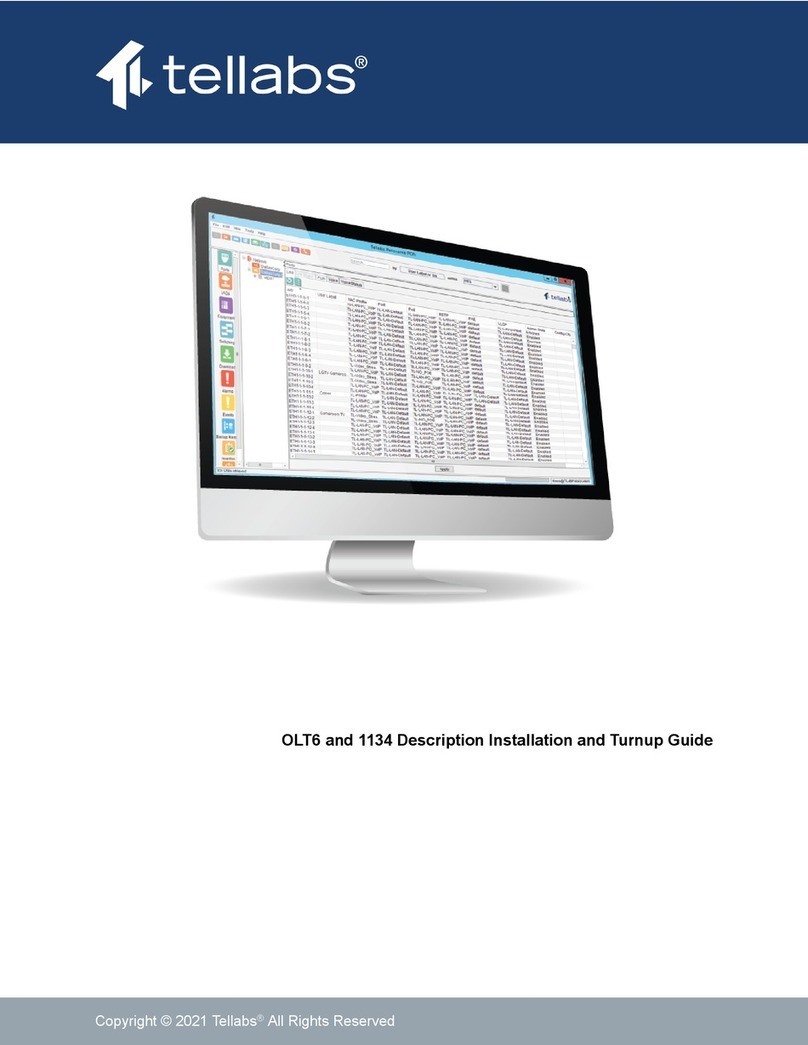
Tellabs
Tellabs FlexSym OLT6 User manual
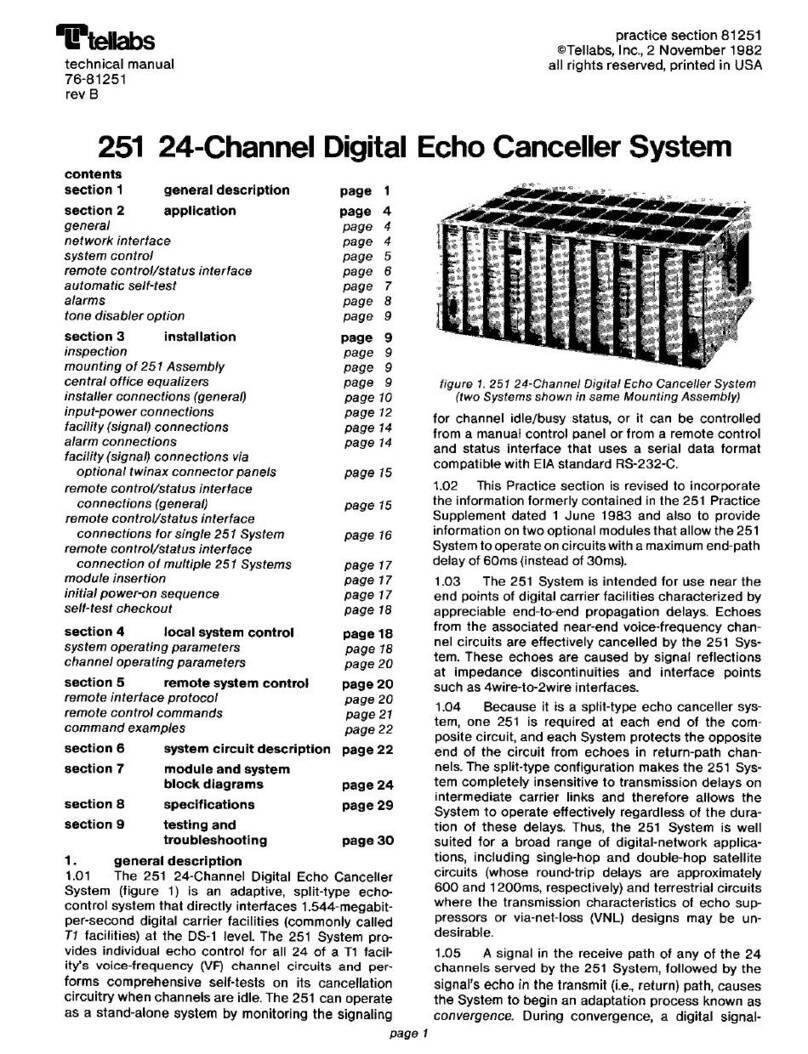
Tellabs
Tellabs 251 User manual

Tellabs
Tellabs 263DC User manual
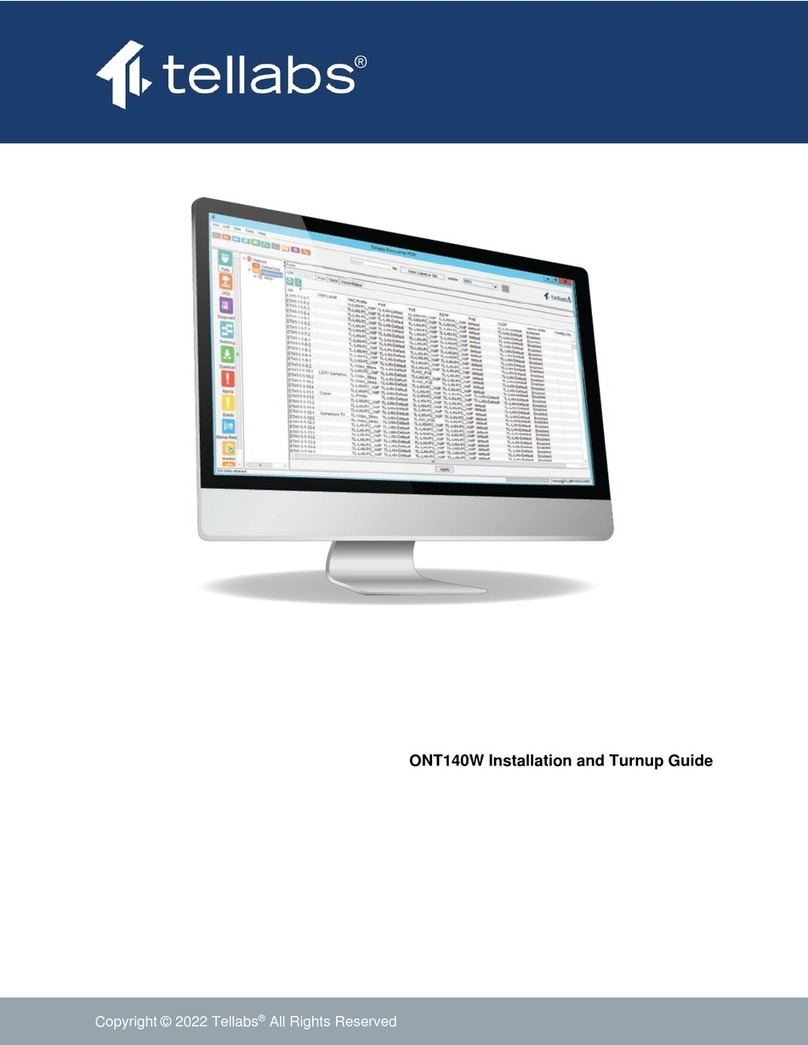
Tellabs
Tellabs 100 Series User manual

Tellabs
Tellabs 6047 User manual
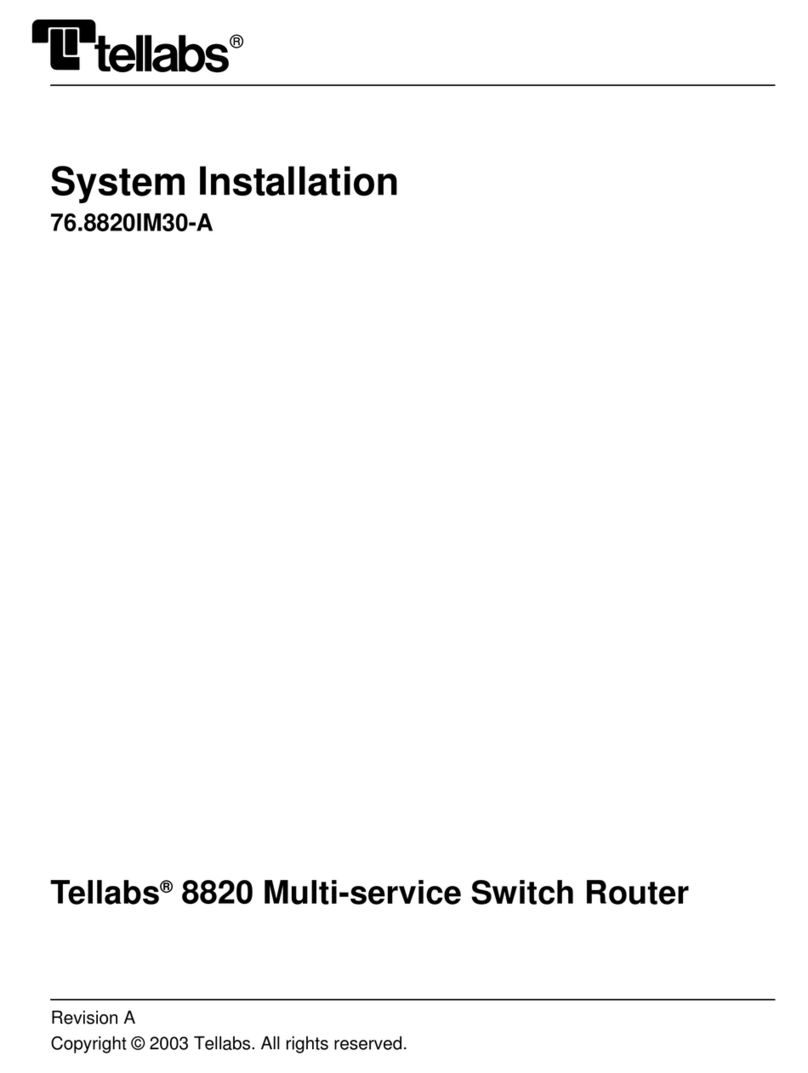
Tellabs
Tellabs 8820 MSR User guide
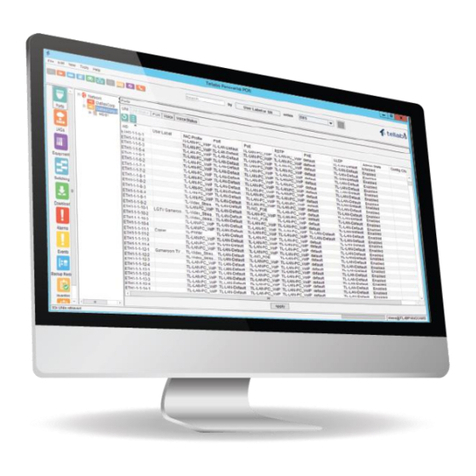
Tellabs
Tellabs FlexSym ONT205 User manual
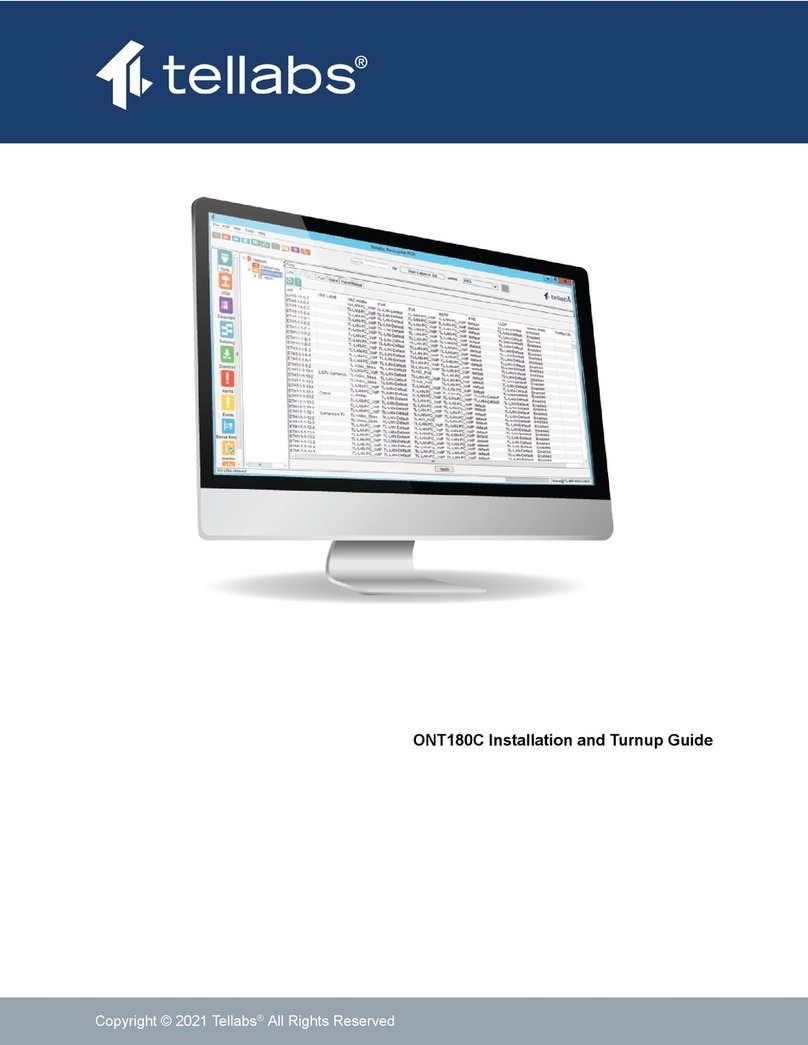
Tellabs
Tellabs ONT180C User manual
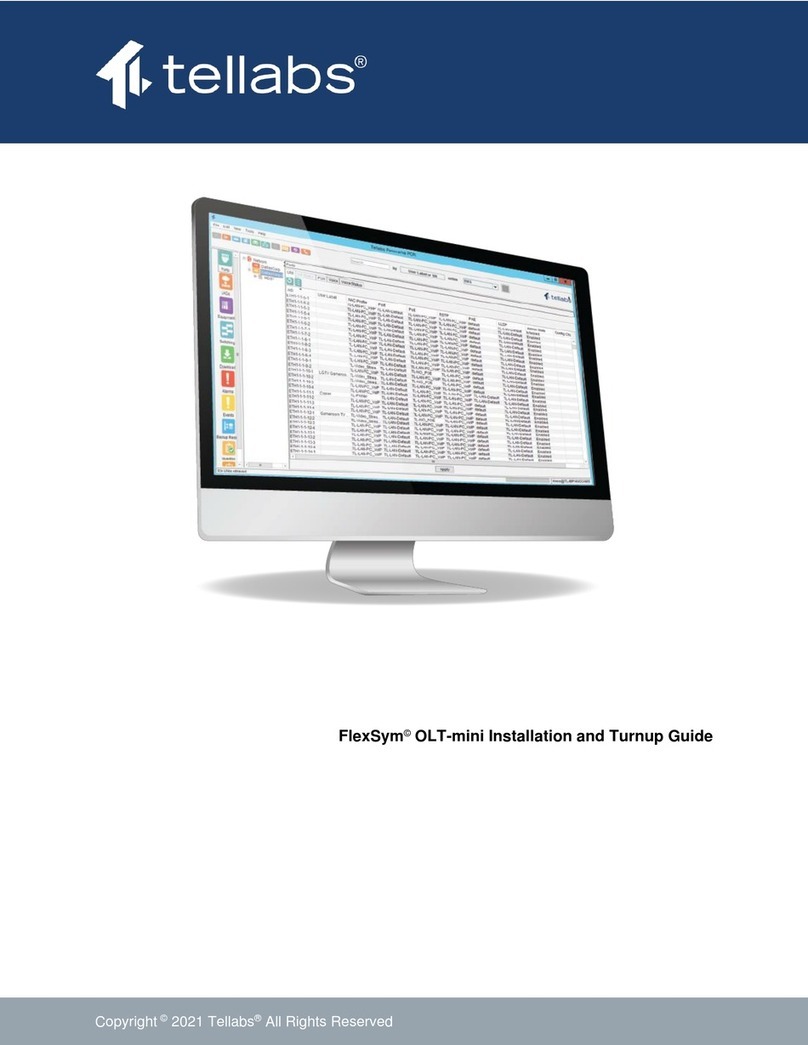
Tellabs
Tellabs FlexSym OLT-mini User manual


